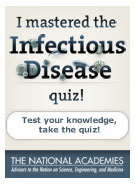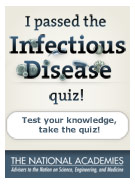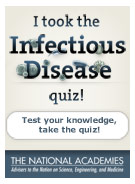
What You Need To Know About Infectious Disease
What do you know about infectious disease?
Which of the following is NOT a type of infectious agent?
-
Sorry, that’s incorrect.
White blood cells are not a type of infectious agent. Part of the immune system, white blood cells fight infection rather than cause it.
-
Sorry, that’s incorrect.
White blood cells are not a type of infectious agent. Part of the immune system, white blood cells fight infection rather than cause it.
-
Correct!
White blood cells are not a type of infectious agent. Part of the immune system, white blood cells fight infection rather than cause it.
-
Sorry, that’s incorrect.
White blood cells are not a type of infectious agent. Part of the immune system, white blood cells fight infection rather than cause it.
Where do microbes live?
-
Sorry, that’s incorrect.
Microbes live in all of these places. They also live in plants and in the air. They can even survive in extreme environments like hot springs, deep ocean thermal vents, and polar ice.
-
Sorry, that’s incorrect.
Microbes live in all of these places. They also live in plants and in the air. They can even survive in extreme environments like hot springs, deep ocean thermal vents, and polar ice.
-
Sorry, that’s incorrect.
Microbes live in all of these places. They also live in plants and in the air. They can even survive in extreme environments like hot springs, deep ocean thermal vents, and polar ice.
-
Sorry, that’s incorrect.
Microbes live in all of these places. They also live in plants and in the air. They can even survive in extreme environments like hot springs, deep ocean thermal vents, and polar ice.
-
Correct!
Microbes live in all of these places. They also live in plants and in the air. They can even survive in extreme environments like hot springs, deep ocean thermal vents, and polar ice.
Of the more than 1,700 known viruses, bacteria, and other pathogens that infect people, how many have come from animals?
-
Sorry, that’s incorrect.
More than half of the known pathogens that infect people have come from animals. Of the 37 new infectious diseases identified in just the past 30 years, two-thirds sprang from animals.
-
Sorry, that’s incorrect.
More than half of the known pathogens that infect people have come from animals. Of the 37 new infectious diseases identified in just the past 30 years, two-thirds sprang from animals.
-
Correct!
More than half of the known pathogens that infect people have come from animals. Of the 37 new infectious diseases identified in just the past 30 years, two-thirds sprang from animals.
Which is the vector (animal that carries the pathogen) for West Nile virus?
-
Sorry, that’s incorrect.
The mosquito is the vector for West Nile virus. The mosquito suffers no ill effects from the virus but transmits it to humans and other warm-blooded creatures (such as crows) when it takes a blood meal.
-
Correct!
The mosquito is the vector for West Nile virus. The mosquito suffers no ill effects from the virus but transmits it to humans and other warm-blooded creatures (such as crows) when it takes a blood meal.
-
Sorry, that’s incorrect.
The mosquito is the vector for West Nile virus. The mosquito suffers no ill effects from the virus but transmits it to humans and other warm-blooded creatures (such as crows) when it takes a blood meal.
-
Sorry, that’s incorrect.
The mosquito is the vector for West Nile virus. The mosquito suffers no ill effects from the virus but transmits it to humans and other warm-blooded creatures (such as crows) when it takes a blood meal.
True or False: Thimerosal, a mercury-containing preservative that was used in some vaccines and other products, has been shown to present a risk to human health.
-
Sorry, that’s incorrect.
The use of thimerosal has been an object of controversy, with some arguing that the substance caused autism in children. However, extensive independent research has presented no convincing evidence of harm associated with the low levels of thimerosal previously present in vaccines.
-
Correct!
The use of thimerosal has been an object of controversy, with some arguing that the substance caused autism in children. However, extensive independent research has presented no convincing evidence of harm associated with the low levels of thimerosal previously present in vaccines.
True or False: Infection with a pathogen (a disease-causing microbe) does not necessarily lead to disease.
-
Correct!
Infection occurs when viruses, bacteria, or other microbes enter your body and begin to multiply. Disease follows when the cells in your body are damaged as a result of infection, and signs and symptoms of an illness appear.
-
Sorry, that’s incorrect.
Infection occurs when viruses, bacteria, or other microbes enter your body and begin to multiply. Disease follows when the cells in your body are damaged as a result of infection, and signs and symptoms of an illness appear.
Which of the following is a bacterial infection?
-
Sorry, that’s incorrect.
Strep throat is a bacterial infection. Hookworm is caused by a parasite and chickenpox and influenza are both caused by viruses.
-
Sorry, that’s incorrect.
Strep throat is a bacterial infection. Hookworm is caused by a parasite and chickenpox and influenza are both caused by viruses.
-
Correct!
Strep throat is a bacterial infection. Hookworm is caused by a parasite and chickenpox and influenza are both caused by viruses.
-
Sorry, that’s incorrect.
Strep throat is a bacterial infection. Hookworm is caused by a parasite and chickenpox and influenza are both caused by viruses.
“Antibiotic resistance” refers to:
- The reluctance of physicians to prescribe antibiotics
- An underground movement against pharmaceutical companies
- The ability of bacteria to resist the effects of an antibiotic
-
Sorry, that’s incorrect.
“Antibiotic resistance” refers to the ability of bacteria to resist the effects of an antibiotic. Antibiotic resistance occurs when bacteria undergo a genetic change that reduces or eliminates the effectiveness of drugs or other agents designed to cure or prevent infection.
-
Sorry, that’s incorrect.
“Antibiotic resistance” refers to the ability of bacteria to resist the effects of an antibiotic. Antibiotic resistance occurs when bacteria undergo a genetic change that reduces or eliminates the effectiveness of drugs or other agents designed to cure or prevent infection.
-
Correct!
“Antibiotic resistance” refers to the ability of bacteria to resist the effects of an antibiotic. Antibiotic resistance occurs when bacteria undergo a genetic change that reduces or eliminates the effectiveness of drugs or other agents designed to cure or prevent infection.
For which of the following diseases do we currently lack an effective vaccine for prevention?
-
Sorry, that’s incorrect.
Although there are treatments available in the form of antivirals, we still currently lack a vaccine for HIV.
-
Sorry, that’s incorrect.
Although there are treatments available in the form of antivirals, we still currently lack a vaccine for HIV.
-
Correct!
Although there are treatments available in the form of antivirals, we still currently lack a vaccine for HIV.
-
Sorry, that’s incorrect.
Although there are treatments available in the form of antivirals, we still currently lack a vaccine for HIV.
Thank you for taking our quiz.
Place this badge on your Facebook page to show your friends what you know about infectious disease.
Place this badge on your Facebook page to show your friends what you know about infectious disease.
OR, get a higher score to unlock a different badge.
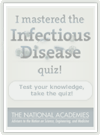
Place this badge on your Facebook page to show your friends what you know about infectious disease.
OR, get a higher score to unlock a different badge.
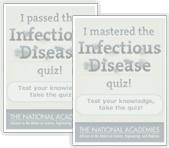
Explore Other Topics
Disease Watchlist
Infectious Disease Defined
- Reservoir
An organism in which a parasite that is pathogenic for some other organism lives and reproduces without harming its host.
